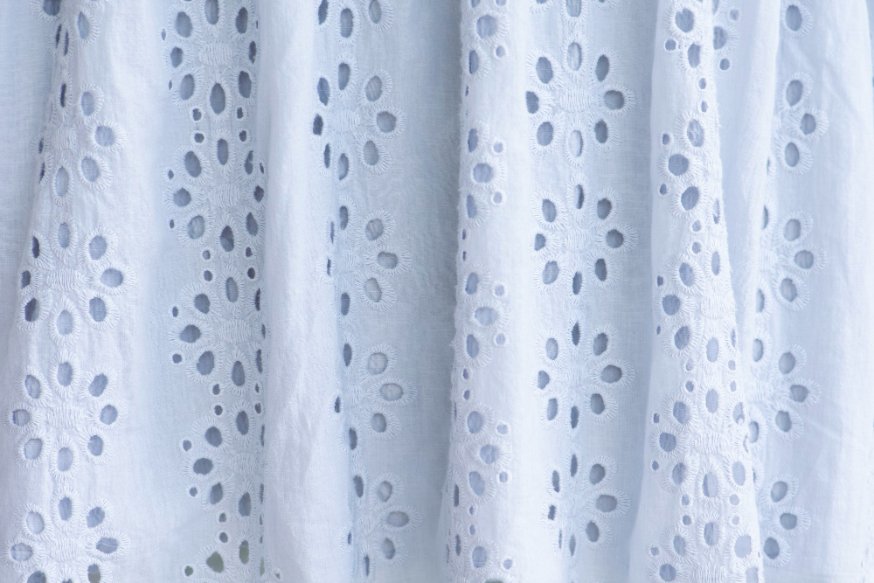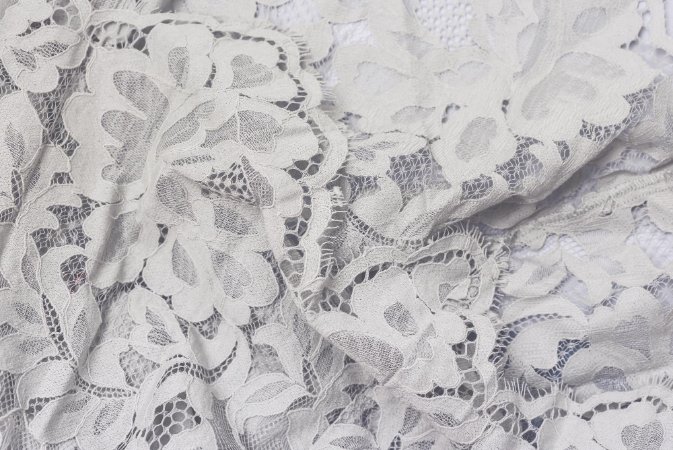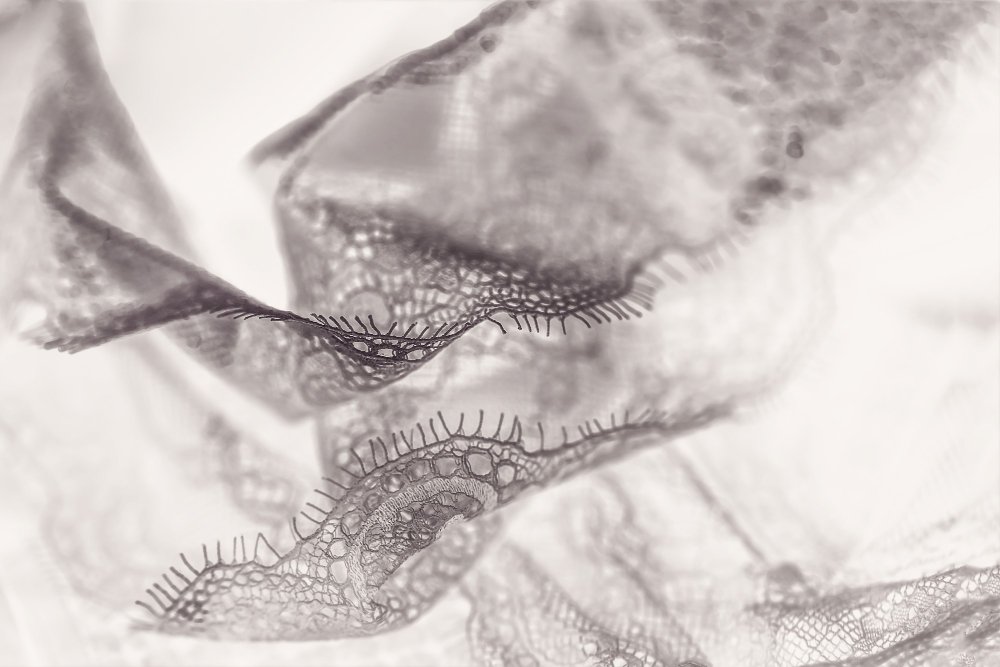Master the art of sewing with this timeless summer textile
Table of Contents
- What is Eyelet Lace Fabric?
- History and Origins
- Types and Varieties
- Fabric Properties and Characteristics
- Broderie Anglaise vs Eyelet Fabric
- Choosing the Right Eyelet Fabric
- Sewing Techniques and Tips
- Care and Maintenance Guide
- Troubleshooting Common Issues
- Project Ideas and Patterns
- Modern Applications and Trends
- Frequently Asked Questions
- Conclusion
What is Eyelet Lace Fabric?
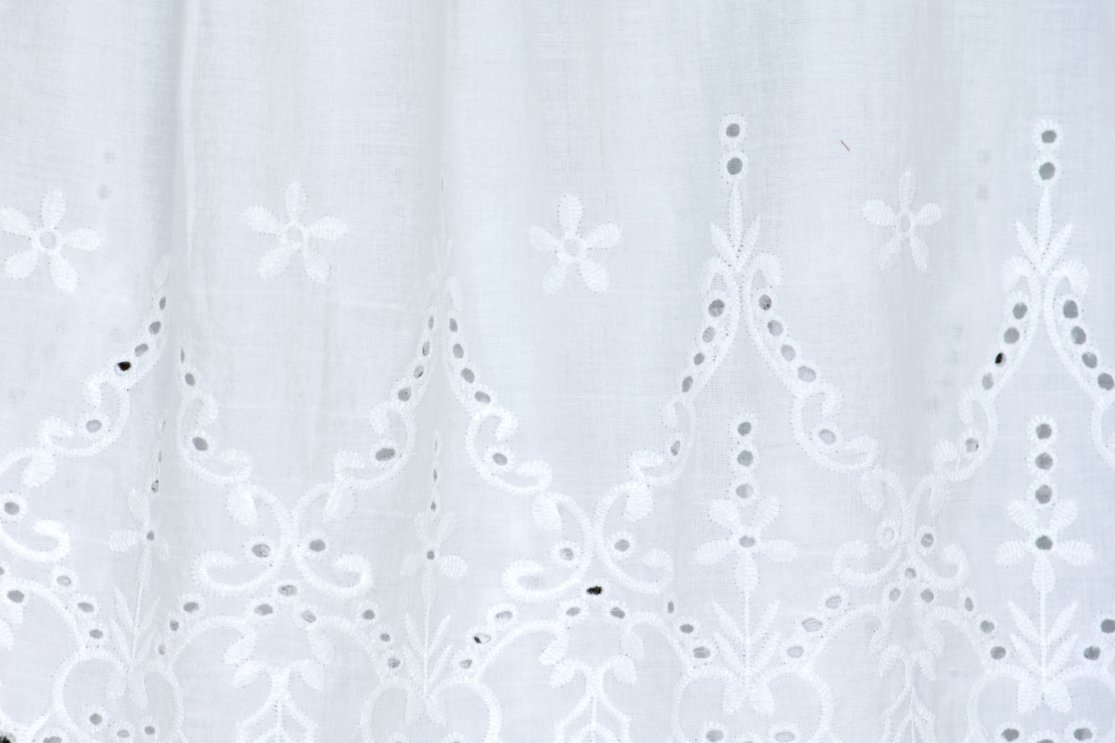
Eyelet lace fabric is a beautiful textile featuring decorative holes (called eyelets) cut into the material and finished with embroidered edges. This creates an airy, romantic look that’s perfect for warm weather clothing and delicate home decor projects.
Key Definition: Eyelet fabric refers to any textile with small, reinforced holes that create patterns throughout the material. The holes are typically round or oval and are finished with dense stitching to prevent fraying.
Unlike other lace fabrics, eyelet maintains a solid base fabric that provides structure and durability. The decorative openings allow air to flow through, making it an ideal choice for summer fabrics and breathable garments.
What Does Eyelet Mean in Clothing?
In clothing terminology, “eyelet” refers to both the technique and the resulting fabric. When you see eyelet mentioned on garment labels or in sewing patterns, it indicates a fabric with decorative perforations that add visual interest while maintaining the structural integrity of the base material.
Breathability
Excellent airflow through decorative holes makes it perfect for hot weather
Durability
Reinforced edges prevent tearing and extend fabric life
Versatility
Works for both casual and formal garments
Easy Care
Most varieties are machine washable with proper techniques
History and Origins
Where Did Eyelet Lace Come From?
The technique we know today as eyelet lace has fascinating historical roots that span several centuries and continents.
16th Century – Eastern Europe
The technique originated in what is now the Czech Republic, where artisans developed methods for creating decorative holes in fabric using embroidery stilettos and careful stitching.
19th Century – English Popularity
The technique gained massive popularity in England during the Victorian era, leading to the French term “broderie anglaise” (English embroidery). It became a staple for women’s underclothing and children’s wear.
1870s – Machine Production
Swiss hand-embroidery machines began copying the designs and techniques, making eyelet fabric more accessible and affordable for everyday use.
1950s – Fashion Revival
Eyelet experienced a major resurgence in the 1950s, becoming popular for dresses and underwear. Brigitte Bardot famously wore an eyelet dress for her 1959 wedding.
Modern Era – Sustainable Fashion
Today’s eyelet fabrics incorporate eco-friendly materials and modern production techniques while maintaining the classic romantic appeal.
Types and Varieties
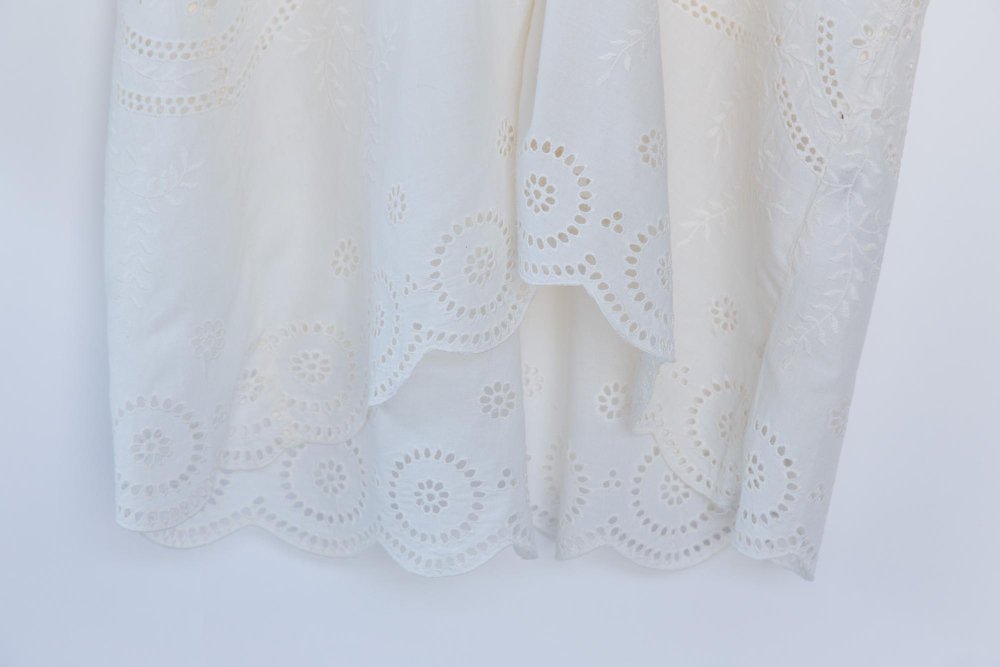
What is Eyelet Lace Made Of?
Modern eyelet fabrics come in various materials, each offering different properties and applications:
| Material | Characteristics | Best Uses | Care Level |
|---|---|---|---|
| 100% Cotton | Breathable, soft, gets softer with washing | Summer dresses, children’s wear, table linens | Easy |
| Cotton Blends | Added durability, wrinkle resistance | Travel clothing, everyday wear | Easy |
| Silk Eyelet | Luxurious drape, natural sheen | Formal wear, bridal garments | Moderate |
| Linen Eyelet | Crisp texture, excellent breathability | Home decor, structured garments | Easy |
| Polyester Blends | Wrinkle-resistant, color-fast | Active wear, easy-care garments | Very Easy |
What is Eyelet Lace Called?
Eyelet lace goes by several names depending on the region and specific technique:
- Broderie Anglaise: The French term meaning “English embroidery”
- English Embroidery: Direct translation of broderie anglaise
- Whitework: When created in traditional white cotton
- Madeira Work: Specific style from Madeira islands
- Swiss Eyelet: Machine-made versions from Swiss manufacturers
Fabric Properties and Characteristics

Understanding the unique properties of eyelet fabric helps you choose the right type for your project and work with it successfully.
Structural Characteristics
Eyelet fabric typically features a plain weave base that provides stability for the decorative cutwork. The reinforced holes are created through dense embroidery stitching that prevents the openings from enlarging or fraying over time.
Pro Tip: Look for fabrics where the embroidery thread matches or complements the base fabric color. This creates a more sophisticated appearance and ensures the decorative elements enhance rather than overpower your finished project.
Identifying Right vs Wrong Side
Distinguishing between the right and wrong sides of eyelet fabric is crucial for successful sewing:
- Right Side: Embroidery appears raised and smooth, holes are clean and well-defined
- Wrong Side: Stitching looks rougher, may have loose threads or zigzag-like overcasting
- Test Method: Run your finger across the embroidered areas – the right side feels smoother
Broderie Anglaise vs Eyelet Fabric
While these terms are often used interchangeably, there are subtle differences worth understanding:
| Aspect | Broderie Anglaise | Modern Eyelet |
|---|---|---|
| Origin | Traditional hand technique from 16th century | Modern machine-made interpretation |
| Construction | Hand-punched holes with hand embroidery | Machine-cut holes with machine stitching |
| Patterns | Often floral, nature-inspired designs | Geometric, abstract, or simplified motifs |
| Quality | Premium, heirloom quality | Varies from basic to high-end |
| Price Range | Higher due to craftsmanship | More accessible pricing |
For more information about different types of lace and their characteristics, you can explore additional resources that explain the broader lace family.
Choosing the Right Eyelet Fabric
Factors to Consider
Selecting the perfect eyelet fabric depends on several key factors:
Project Type
- Garments: Consider drape and stretch
- Home decor: Focus on durability
- Children’s items: Prioritize washability
Hole Size
- Small holes: More formal appearance
- Large holes: Casual, bohemian style
- Mixed sizes: Dynamic visual interest
Fabric Weight
- Lightweight: Flowing garments
- Medium weight: Structured pieces
- Heavy weight: Home furnishings
Edge Finishing
- Scalloped edges: Built-in hem
- Straight edges: More versatile
- Border patterns: Design integration
Quality Indicators
Look for these signs of high-quality eyelet fabric:
- Dense, even stitching around holes
- No loose threads or incomplete embroidery
- Consistent hole sizes within patterns
- Smooth, well-finished base fabric
- Colorfast dyes that won’t run
Quality Warning: Very inexpensive eyelet fabric may have excessive starch or sizing to mask poor base fabric quality. Always prewash a sample to test the true fabric characteristics.
Sewing Techniques and Tips
How to Use Eyelet Lace
Working with eyelet fabric requires some special considerations, but the results are worth the extra attention to detail.
Essential Preparation Steps
- Prewash Your Fabric
Always prewash eyelet fabric in warm water with similar colors. This prevents shrinkage in your finished garment and softens the fabric for easier handling. - Identify Right and Wrong Sides
Mark the right side with small safety pins or thread markers before cutting to avoid confusion during construction. - Plan Pattern Placement
Use transparent tissue paper to visualize how decorative elements will fall on your finished piece. Avoid placing seams through large decorative motifs.
Cutting and Marking Techniques
Proper cutting and marking are crucial for successful eyelet projects:
Marking Method: Never use colored chalk or pens on eyelet fabric as they can permanently stain the embroidered threads. Instead, use tailor’s tacks or removable thread markers.
- Cut with sharp fabric scissors to prevent snagging
- Use pinking shears for internal seams to reduce fraying
- Start cutting from center front and work outward for even pattern placement
- Consider using rotary cutters for long straight edges
Machine Settings and Needles
Proper machine setup prevents damage to delicate eyelet fabric:
| Setting | Recommendation | Reason |
|---|---|---|
| Needle Type | Sharp/Microtex 70/10 or 80/12 | Pierces cleanly without snagging embroidery |
| Thread | High-quality cotton or polyester | Matches fabric content for best results |
| Stitch Length | 2.0-2.5mm | Prevents puckering while securing fabric |
| Tension | Slightly reduced | Accommodates fabric thickness variations |
Seam Finishing Options
Since seams may be visible through eyelet holes, choose appropriate finishing methods:
- French Seams: Best for unlined garments, creates clean enclosed seams
- Serged/Overlocked: Quick option when using matching thread color
- Pinked Seams: Traditional method for cotton eyelet
- Bound Seams: Professional finish for special garments
For more detailed guidance on seam finishing, check out our comprehensive seam allowance troubleshooting guide.
Working with Scalloped Edges
Many eyelet fabrics feature beautiful scalloped selvages that can be incorporated into your design:
Straight Edges Only
Use scalloped edges for: hem lines, sleeve cuffs, necklines, and straight skirts. The natural curve adds elegant detail without additional work.
Curved Seams
Cut scalloped edge as separate trim for curved areas. Apply as bias binding or decorative overlay for professional results.
Pattern Modifications
Adjust pattern pieces to accommodate scalloped edge placement. This may require lengthening or shortening certain sections.
Stabilizing Techniques
Some eyelet projects benefit from additional stabilization:
- Use lightweight interfacing on necklines and armholes
- Apply to lining rather than eyelet fabric directly
- Consider stay-stitching for curved seams
- Use silk organza for minimal visibility
Learn more about different sewing machine stitches that work best with delicate fabrics like eyelet.
Video Tutorial: Easy Tricks for Sewing with Eyelet
Watch this helpful video tutorial for practical tips on working with eyelet fabric and avoiding common mistakes.
Care and Maintenance Guide
Proper care ensures your eyelet garments and projects maintain their beauty for years to come.
Washing Instructions
Hand Washing Method (Recommended)
- Prepare Washing Solution
Fill a clean basin with lukewarm water (never hot) and add a small amount of mild detergent designed for delicate fabrics. - Gentle Agitation
Submerge the eyelet item and gently swish it around. Never rub, scrub, or wring the fabric as this can damage the delicate embroidery. - Soaking Time
Allow the fabric to soak for 10-15 minutes for light cleaning, or up to 30 minutes for heavily soiled items. - Thorough Rinsing
Rinse with clean, lukewarm water until all soap residue is removed. Change water multiple times if necessary. - Water Removal
Gently press the fabric against the basin sides to remove excess water. Never wring or twist the delicate embroidery.
Machine Washing Guidelines
When hand washing isn’t practical, follow these machine washing precautions:
Machine Washing Caution: Always place eyelet items in a mesh laundry bag or pillowcase to protect them from snagging on other garments or machine components.
- Use delicate or hand-wash cycle only
- Cold water temperature (30°C/86°F maximum)
- Mild detergent without bleach or fabric softeners
- Wash with similar colors and fabric weights
- Remove promptly when cycle completes
Drying Techniques
Air Drying (Recommended)
Proper drying techniques preserve the fabric’s structure and prevent damage:
- Initial Water Removal
Lay the wet item flat on a clean, dry towel. Roll the towel gently to absorb excess moisture without wringing. - Flat Drying Setup
Place the item on a fresh, dry towel away from direct sunlight and heat sources. Reshape gently to original dimensions. - Turning Process
Flip the item occasionally to ensure even drying on both sides. This prevents moisture from becoming trapped in the embroidered areas.
Drying Location: Choose a well-ventilated area with good air circulation but avoid direct sunlight, which can cause yellowing or fading of the fabric and embroidery threads.
Machine Drying Considerations
While air drying is preferred, some eyelet fabrics can tolerate machine drying:
- Only if care label specifically allows
- Use lowest heat setting or air-dry cycle
- Remove while slightly damp to prevent over-drying
- Never use high heat, which can melt synthetic embroidery threads
Ironing and Pressing
Proper pressing techniques maintain the fabric’s appearance without damaging delicate embroidery:
Iron Settings
| Fabric Type | Temperature | Steam Setting | Special Notes |
|---|---|---|---|
| Cotton Eyelet | Medium (Cotton setting) | Light steam | Press from wrong side |
| Cotton Blend | Medium-Low | Light steam | Test on sample first |
| Silk Eyelet | Low (Silk setting) | No steam | Use press cloth |
| Synthetic Blend | Low | No steam | Press cloth essential |
Pressing Technique
- Always press from the wrong side to protect embroidery
- Use a press cloth to prevent direct contact with decorative elements
- Press gently without dragging the iron
- Allow fabric to cool completely before moving
- Avoid pressing directly over raised embroidery
Storage Recommendations
Proper storage prevents damage and maintains fabric quality:
Short-Term Storage
- Hang on padded hangers to prevent creasing
- Use garment bags for dust protection
- Ensure complete dryness before storing
Long-Term Storage
- Fold with acid-free tissue paper
- Store in breathable cotton bags
- Avoid plastic bags that trap moisture
Environmental Factors
- Cool, dry location away from sunlight
- Good air circulation
- Stable temperature and humidity
For comprehensive fabric care information, explore our detailed cotton care guide which covers many techniques applicable to eyelet fabrics.
Troubleshooting Common Issues
Even experienced sewers encounter challenges when working with eyelet fabric. Here are solutions to the most common problems:
Needle Breaking or Skipping
Problem: Machine needle breaks when sewing through thick embroidered areas.
Solution: Use a sharp, sturdy needle (80/12 or 90/14). Sew slowly through heavy embroidery sections and consider using a walking foot.
Visible Seam Allowances
Problem: Seam allowances show through eyelet holes, creating an unfinished appearance.
Solution: Use French seams, serge with matching thread, or line the garment with a coordinating fabric.
Puckering Around Holes
Problem: Fabric puckers around eyelet openings during or after sewing.
Solution: Reduce machine tension, use a shorter stitch length, and consider temporary stabilizer for problem areas.
Fraying Embroidery Threads
Problem: Decorative stitching begins to unravel at hole edges.
Solution: Apply clear nail polish or fabric sealant sparingly to affected areas. For prevention, handle fabric gently and avoid over-manipulation.
Pattern Misalignment
Problem: Decorative motifs don’t align properly across seam lines.
Solution: Plan pattern placement during cutting. Use transparent overlay to visualize pattern matching before cutting pieces.
Staining During Marking
Problem: Marking tools leave permanent stains on delicate embroidery.
Solution: Use only tailor’s tacks, removable thread markers, or water-soluble marking pens tested on fabric scraps first.
Prevention Strategies
Avoid common problems with these proactive measures:
- Always test techniques on fabric scraps before working on your project
- Keep machine needles sharp and replace frequently
- Clean your sewing machine regularly to prevent thread buildup
- Store fabric properly to maintain quality
- Plan your sewing sequence to minimize handling
For more detailed troubleshooting help, visit our comprehensive sewing machine troubleshooting guide.
Project Ideas and Patterns
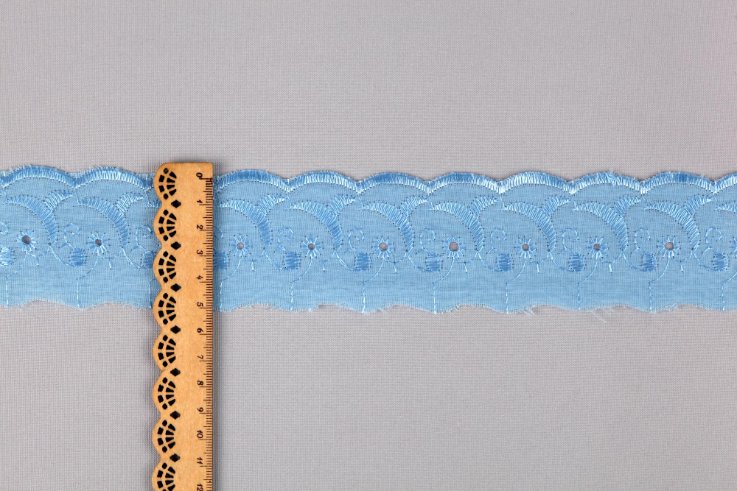
How to Use Eyelet Lace in Your Projects
Eyelet fabric’s versatility makes it perfect for a wide range of projects, from simple accessories to complex garments.
Beginner-Friendly Projects
Simple A-Line Skirt
Perfect first project using scalloped edge as natural hem. Minimal seaming showcases the fabric beautifully.
Pillowcase Set
Great for practicing French seams and incorporating decorative edges. Quick results build confidence.
Table Runner
Straight lines make cutting simple while allowing focus on proper pressing and finishing techniques.
Baby Bib
Small scale project perfect for learning how to work with curved edges and binding techniques.
Intermediate Projects
- Sleeveless Blouse: Practice with armhole finishing and neckline treatments
- Gathered Skirt: Learn to work with fullness while maintaining pattern alignment
- Child’s Dress: Combine multiple techniques including gathering, facings, and hems
- Cafe Curtains: Perfect for learning about header construction and rod pocket techniques
Advanced Projects
- Tailored Blazer: Challenge your skills with structured construction and interfacing techniques
- Wedding Dress: Ultimate test of pattern matching, fitting, and finishing skills
- Lined Coat: Complex construction requiring careful planning and execution
- Heirloom Bedding Set: Large-scale project with multiple components and finishing details
Pattern Selection Guidelines
Pattern Tip: Choose patterns with minimal seaming to showcase the fabric’s natural beauty. Avoid designs with multiple darts or complex construction that might interfere with the decorative elements.
Best Pattern Features for Eyelet
- Simple, classic silhouettes that don’t compete with fabric detail
- Straight or gently curved seam lines
- Minimal darts and construction details
- Opportunities to showcase scalloped edges
- Flowing, feminine designs that complement the romantic aesthetic
Patterns to Avoid
- Circle skirts (can’t utilize scalloped edges effectively)
- Heavily darted or fitted designs
- Patterns with many small pieces
- Designs requiring extensive topstitching
- Ultra-modern, geometric styles that clash with traditional eyelet aesthetic
Learn more about reading sewing patterns to help you choose the best designs for your eyelet projects.
How to Crochet with Eyelet Lace
While eyelet fabric isn’t typically used in traditional crochet, you can incorporate it into crochet projects as trim or backing:
- Edging Trim: Cut narrow strips of eyelet to use as decorative edging on crocheted blankets
- Applique Base: Use small eyelet pieces as foundation for crocheted appliques
- Mixed Media Projects: Combine crocheted elements with eyelet fabric panels for unique garments
- Backing Fabric: Use lightweight eyelet as backing for delicate crochet shawls
How to Use Fabric Glue on Lace
When working with eyelet fabric, fabric glue can be useful for certain applications:
Glue Application Warning: Always test fabric glue on scraps first. Some adhesives can discolor or stiffen delicate embroidery threads permanently.
Appropriate Uses for Fabric Glue
- Temporary basting before permanent stitching
- Securing applique pieces for stitching
- Preventing fraying on cut edges (sparingly applied)
- Attaching trim or decorative elements
Application Technique
- Choose washable, clear-drying fabric glue
- Apply thin, even coats using a small brush or applicator
- Work in small sections to prevent over-application
- Allow complete drying before handling
- Test wash a sample piece before finishing project
Modern Applications and Trends
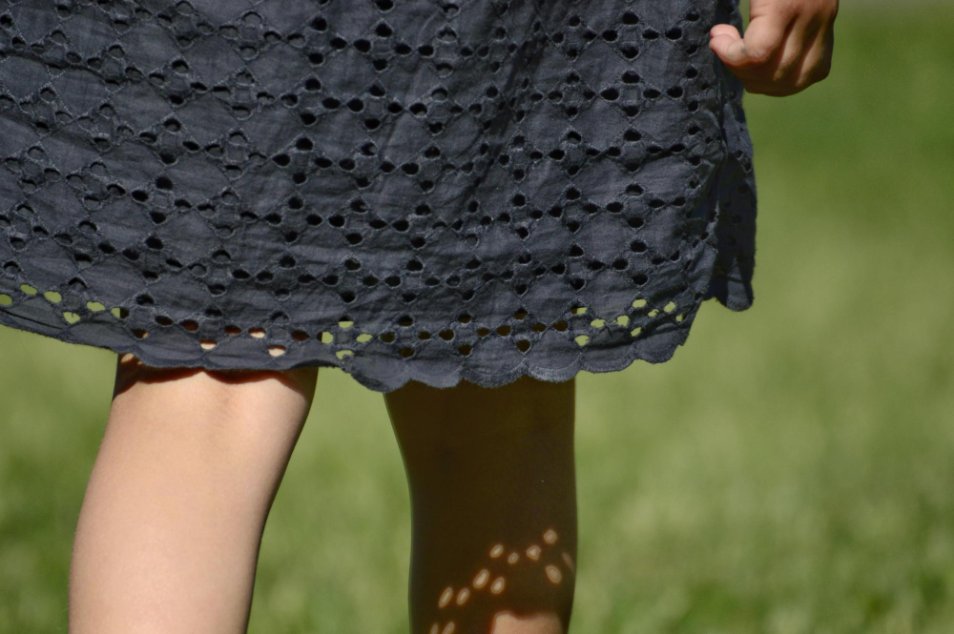
Today’s designers are rediscovering eyelet fabric and incorporating it into contemporary fashion and home decor in fresh, innovative ways.
2025 Fashion Trends
Eyelet fabric aligns perfectly with several major fashion trends:
Sustainable Fashion
Natural fiber eyelet supports the eco-conscious movement with biodegradable materials and timeless appeal that transcends seasonal trends.
Romantic Femininity
The return of feminine details and romantic silhouettes makes eyelet fabric particularly relevant for modern wardrobes.
Artisanal Craftsmanship
Growing appreciation for handmade and traditional techniques puts quality eyelet work in the spotlight.
Earth Tone Palette
Modern eyelet comes in natural, earthy colors that complement 2025’s focus on organic, nature-inspired hues.
Contemporary Design Applications
Modern designers are pushing traditional boundaries with creative eyelet applications:
- Layering Pieces: Sheer eyelet over solid fabrics creates depth and visual interest
- Mixed Textures: Combining eyelet with leather, denim, or technical fabrics for contrast
- Bold Colors: Moving beyond traditional white to embrace vibrant, modern colorways
- Oversized Silhouettes: Using delicate eyelet in dramatically large proportions
- Minimalist Approach: Simple cuts that let the fabric’s inherent beauty take center stage
Home Decor Innovations
Interior designers are incorporating eyelet fabric in creative ways:
Window Treatments
Light-filtering panels create soft, diffused lighting while maintaining privacy. Perfect for layering with heavier drapes.
Room Dividers
Eyelet panels on decorative frames create semi-private spaces while allowing light flow in open floor plans.
Accent Pillows
Mix eyelet with solid fabrics for textural contrast. The holes create interesting shadow patterns in different lighting.
Table Linens
Modern eyelet table runners and placemats add elegant texture to contemporary dining spaces without feeling overly traditional.
Explore more about current fabric trends for 2025 to see how eyelet fits into the broader textile landscape.
Digital Age Considerations
Modern technology has enhanced eyelet fabric production and design:
- Computer-Aided Design: More complex and precise patterns than ever before
- Eco-Friendly Dyes: Low-impact coloring processes that maintain fabric integrity
- Blended Fibers: Smart combinations that improve performance while maintaining aesthetic appeal
- Online Resources: Digital pattern matching and design tools for home sewers
Frequently Asked Questions
Lace eyelets are the small, reinforced holes that form the decorative pattern in eyelet fabric. These holes are cut into the base fabric and then finished with dense embroidery stitching to prevent fraying and create decorative borders around each opening.
Yes, most cotton and cotton blend eyelet fabrics can be machine washed on a gentle cycle with cold water. Always use a mesh laundry bag to protect the delicate embroidery, and avoid fabric softeners that can build up in the decorative stitching.
Broderie anglaise is the traditional hand-embroidered technique that originated in 16th century Europe, while “eyelet” is the broader modern term that includes both hand and machine-made versions. Broderie anglaise typically features more intricate, nature-inspired patterns, while modern eyelet can include geometric or simplified designs.
The embroidered edges around each hole are designed to prevent fraying, but cut edges need proper finishing. Use pinking shears, serger/overlock stitching, or French seams. For raw edges that might fray, apply a small amount of clear nail polish or fabric sealant.
Use a sharp/microtex needle in size 70/10 for lightweight eyelet or 80/12 for medium-weight fabrics. The sharp point pierces cleanly through both the base fabric and embroidered areas without snagging or creating large holes.
Yes, but always iron from the wrong side to protect the embroidery. Use appropriate temperature settings for the base fabric (medium for cotton, low for synthetic blends) and consider using a press cloth to prevent direct contact with raised embroidery elements.
While eyelet is traditionally a summer fabric due to its breathable nature, it can work for winter when properly layered. Use it as an overlay over solid fabrics, or choose heavier weight eyelet for winter accessories like scarves or decorative accents on coats.
Use transparent tissue paper to trace the pattern before cutting. Lay it over the fabric to visualize how motifs will align across seam lines. Plan your cutting layout to avoid breaking up large decorative elements, and consider the pattern repeat when calculating fabric requirements.
Start with simple projects like pillowcases, table runners, or A-line skirts that can utilize scalloped edges as natural hems. These projects have minimal seaming, allow you to practice basic techniques, and showcase the fabric’s beauty without complex construction challenges.
Store eyelet fabric in a cool, dry place away from direct sunlight. For short-term storage, hang on padded hangers or fold loosely with acid-free tissue paper. Long-term storage should be in breathable cotton bags rather than plastic, which can trap moisture and cause mildew.
Conclusion
Eyelet lace fabric remains one of the most versatile and enduring textiles in both fashion and home decor. Its unique combination of delicate beauty and practical functionality makes it a valuable addition to any sewing collection, whether you’re creating heirloom garments or contemporary pieces.
Throughout this comprehensive guide, we’ve explored how this centuries-old technique has evolved from hand-embroidered European origins to today’s machine-produced fabrics that maintain the same romantic appeal while offering improved durability and accessibility. The key to successful eyelet projects lies in understanding the fabric’s unique properties and adapting your techniques accordingly.
Essential Takeaways for Success
- Fabric Selection: Choose quality eyelet with dense, even stitching around holes and a stable base fabric appropriate for your project’s requirements
- Preparation is Crucial: Always prewash your fabric, identify right and wrong sides clearly, and plan pattern placement to showcase decorative elements effectively
- Sewing Techniques Matter: Use sharp needles, appropriate thread, and gentle handling. Consider French seams or serged finishes since seams may be visible through the holes
- Care Extends Life: Hand washing or gentle machine cycles, air drying, and proper storage significantly extend the life and beauty of eyelet garments
- Modern Relevance: Today’s eyelet fabrics support sustainable fashion trends while offering fresh design possibilities through contemporary colors and applications
Moving Forward with Confidence
Whether you’re drawn to eyelet fabric for its historical significance, practical benefits, or aesthetic appeal, remember that successful projects start with proper planning and preparation. Don’t be intimidated by the delicate appearance – with the right techniques and care, eyelet fabric is remarkably forgiving and rewarding to work with.
Start with simple projects to build your confidence and understanding of how the fabric behaves. As you gain experience, you’ll discover new ways to incorporate this beautiful textile into your creative work, from traditional applications to innovative modern interpretations.
Resources for Continued Learning
The world of lace fabrics extends far beyond eyelet, and exploring related techniques like embroidered lace or cotton lace varieties can enhance your understanding and expand your creative possibilities.
Remember that mastery comes with practice, and each project teaches valuable lessons that inform your next creation. The timeless appeal of eyelet fabric means that skills learned today will serve you well for years to come, creating beautiful, lasting pieces that celebrate both tradition and personal creativity.
Final Recommendation: Keep samples of different eyelet types, weights, and qualities in your fabric collection. These references will help you make informed decisions for future projects and serve as testing grounds for new techniques before working on important pieces.

